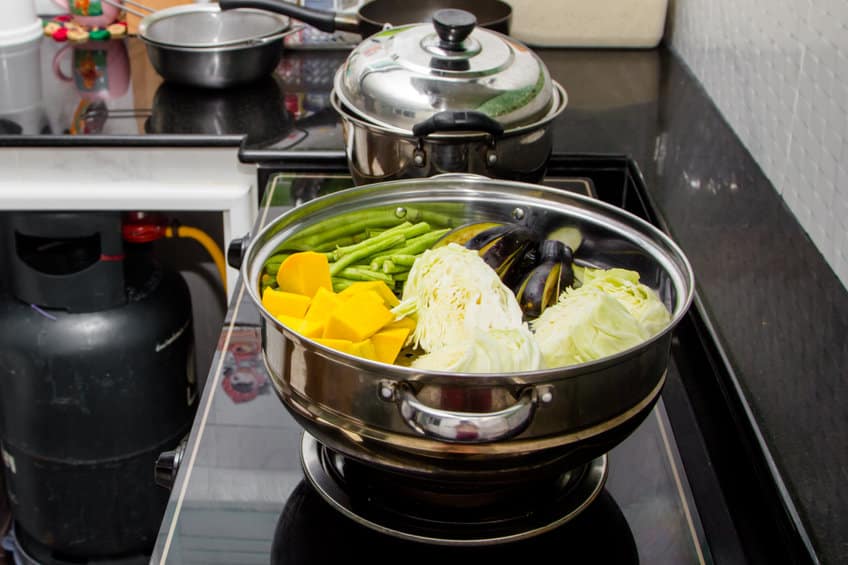By Kathy Driscoll –
Eating a balanced diet with as many fruits and vegetables as possible has always been the prize, something so important it rates setting it as a goal that gets posted on the front of a refrigerator. There’s a good reason for this too. Whether it’s adding more carrots to the stew, putting spinach into pasta or reaching for raw vegetables to dip into hummus, there is no question that a diet rich in fruits and vegetables provides vital nutrients usually at the expense of fewer calories.
What is too often less considered is how cooking these vegetables affects the nutritional equation. Ultimately, do the veggies in question retain their fair share of nutrients after they’ve been steamed, boiled, roasted or fried? For years, the food police have spread the notion that cooking takes away precious nutrients and that fruits and vegetables only deliver their maximum benefits if eaten raw. But it might be surprising to hear that isn’t necessarily the case.
“Common wisdom says cooked vegetables have fewer nutrients than fresh ones, but that isn’t always the case,” noted Consumer Reports dietitian Amy Keating. “Some nutrients in fruits and vegetables are bound in the cell walls. Cooking breaks those walls down, releasing the nutrients so your body can absorb them more easily.” So, in other words, there might be more nutritional bang for the buck if some vegetables are eaten cooked rather than raw.
Spinach, for example, which is considered a nutritional winner, is packed with oxalic acid, which blocks the absorption of iron and calcium. Unfortunately, it breaks down under high temperatures. One study, in fact, found that oxalate content was reduced when spinach was cooked quickly in boiling water, then dropped into cold water.
Conversely, some vegetables like mushrooms, carrots and tomatoes can not only take the heat, but they also thrive nutritionally when getting hot and bothered. Take a cup of cooked white mushrooms. It has about twice as much potassium, niacin, zinc and magnesium as a cup of raw ones.
The Journal of Agricultural and Food Chemistry offered another example in boiled carrots. It noted that boiling them until tender increased their concentration of carotenoids – the cancer-fighting nutrient that makes carrots orange – by 14 percent. There is a catch, however. They have to be boiled whole. Slicing them before boiling lets their inherent nutrients seep into the cooking water.
When it comes to tomatoes, there is good news and bad news. Boiling tomatoes definitely destroys or significantly reduces vitamin C, considered a water-soluble and temperature-sensitive vitamin. However, if those same tomatoes are baked, fried or even pureed into spaghetti sauce, more lycopene is generated, which can help lower the rate of heart disease and cancer.
Raw broccoli and cauliflower contain helpful glucosinolates, which translate into cancer-fighting compounds in the body if activated by an enzyme called myrosinase. Unfortunately, these same vegetables also contain cellulose and raffinose, which can cause bloating, gas and other problems. Consumer Reports noted that this means some might be better off eating them cooked, especially since it will be easier on the digestive system. Keating does note there is a nutritional middle ground in steaming. This preserves myrosinase and the cancer-fighting compounds. Just by chopping the broccoli and letting it sit before steaming.
In general, nutrients in meat or produce that is easily deactivated during the cooking process include water-soluble nutrients such as vitamins C and B, including thiamine, riboflavin, niacin, pantothenic acid, pridozine, folic acid and cobalamin, Healthline.com reported. Up to 60 percent of thiamine, niacin and other B vitamins, for example, may be lost when meat is simmered.
Ultimately, there is no exact roadmap for what’s better cooked versus raw. But foods that are considered healthier when raw include: cabbage, onions and garlic. Those that benefit from a bit if heat cover, among others, asparagus, mushrooms, spinach, tomatoes, carrots, potatoes and legumes.
For preserving nutrients, steaming and microwaving seems to rank high in terms of nutrient retention, along with roasting and baking. Sauteing and stir-frying, which require cooking in a saucepan over medium to high heat in a small amount of butter or oil, are also considered healthy cooking methods. In general, boiling, poaching and frying tend to squeeze out nutrients.
“There is no perfect cooking method that retains all nutrients,” Keating reported. “In general, cooking for shorter periods at lower temperatures with minimal water will produce the best results.”













